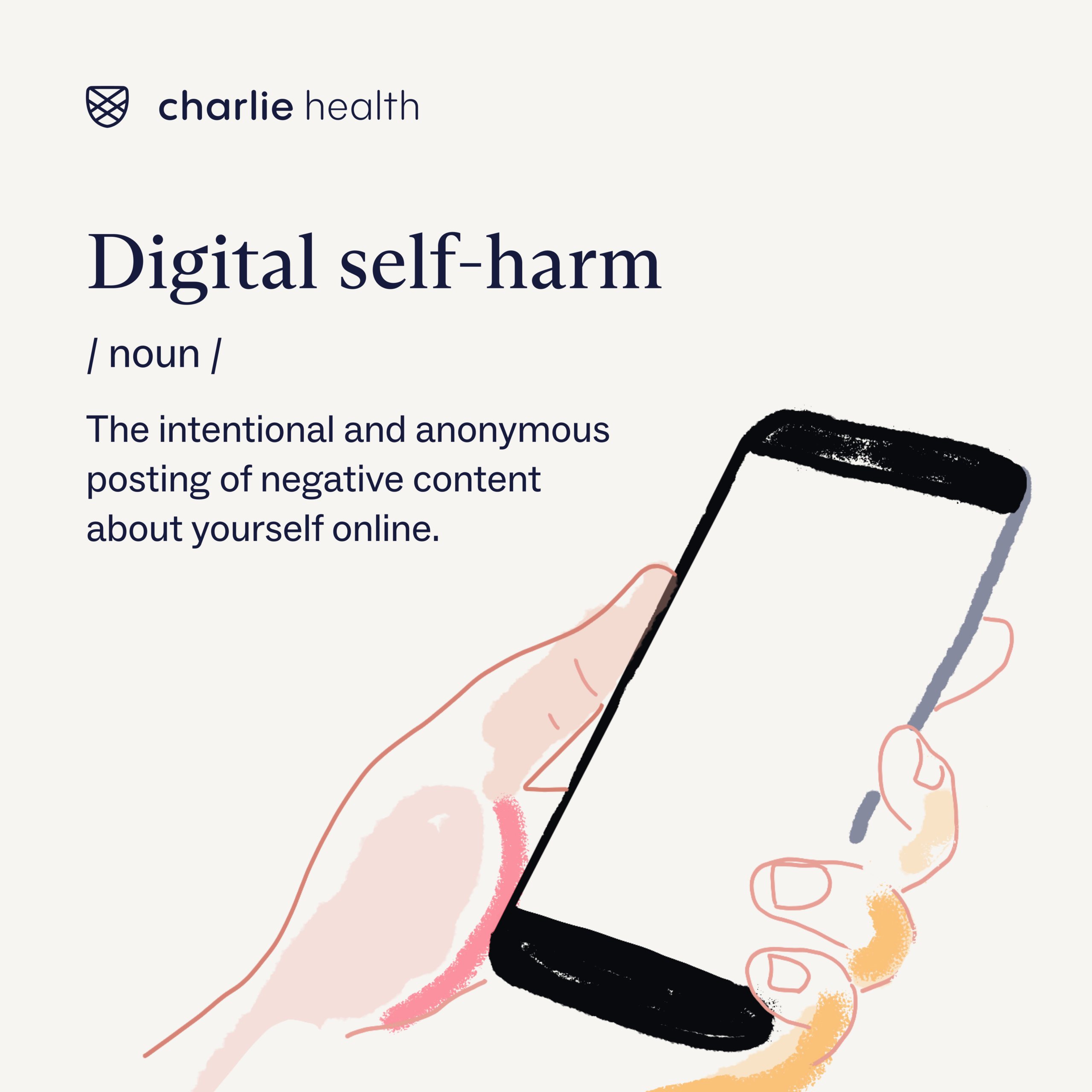
Table of Contents
Yes, Digital Self-Harm Is Real—Here’s What You Need to Know

Written By: Sarah duRivage-Jacobs

Clinically Reviewed By: Dr. Don Gasparini
Updated: December 14, 2023
7 min.
An increasing number of teens and young adults are anonymously posting, sending, or sharing hurtful content about themselves online—a dangerous phenomenon known as digital self-harm.
Learn more about our Clinical Review Process
Table of Contents
Many teens and parents are familiar with physical self-harm, behaviors meant to inflict physical harm on oneself, usually to cope with negative feelings. Far fewer may know about the related, though distinct, digital form of self-harm—a concept that first appeared in medical literature in 2012 referring to acts of harm inflicted upon oneself online.
A year later, digital self-harm entered public awareness when a 14-year-old died by suicide after sending hurtful messages to herself on a social media site. A few years later, another young adult died by suicide after similar circumstances. While digital self-harm is a fairly new phenomenon, here’s what we know about it so far.

Healing is possible
We offer personalized treatment for complex mental health conditions.
What is digital self-harm?
The definition of “digital self-harm” varies across studies, but researchers have defined it as “anonymous online posting, sending, or otherwise sharing of hurtful content about oneself.”
The term digital self-harm encompasses the act of sending oneself hurtful content through text, email, social media platforms, gaming consoles, web forums, and any other virtual platforms. Digital self-harm might look like someone creating a fake account to post mean comments on their own Instagram photos or send insulting tweets or cruel email messages to themselves.
Other research has described the phenomenon using the terms “fictitious online victimization,” “digital Munchausen,” “self-cyberbullying,” and “self-trolling.” (Digital Munchausen refers to an online version of Munchausen Syndrome—a disorder in which a person attempts to gain attention and sympathy by pretending to be physically ill.)

Why is digital self-harm considered “fictitious”?
In simple terms, the “fictitious” in “fictitious online victimization” reflects the theory that digital self-harm is made up. “Digital Munchausen,” another term used to describe digital self-harm, also suggests that someone who is digitally self-harming is only pretending to do so. But is digital self-harm fake or made-up? Not exactly.
The idea that digital self-harm isn’t “real” stems from the fact that it’s often self-created or anonymous. While this may seem counterintuitive, people (especially adolescents) often digitally self-harm to alleviate uncomfortable feelings or emotional pain. Instead of undermining the idea of digital self-harm, self-creation and anonymity are actually definitive characteristics of digital self-harm.
For example, a 2022 review of the existing literature on digital self-harm highlighted a study in which people recovering from eating disorders purposely viewed or created online content about restriction and other forms of disordered eating to continue to encourage them to harm themselves. In some studies, the umbrella category of digital self-harm also encompasses this behavior.
Is digital self-harm the same thing as cyberbullying?
No, digital self-harm is unique from cyberbullying. While cyberbullying can be defined as repeated, intentional person-to-person harm via technology, with digital self-harm, the sender and receiver of the hateful messages are the same individual. Digital self-harm messages typically come from an anonymous or pseudonymous account rather than one that’s known to be attached to the receiver.
How common is digital self-harm among teens and young adults?
According to one 2017 study that analyzed a data sample representative of Americans ages 12-17, around 6% of the population had engaged in anonymous digital self-harm. The rate was higher among those assigned male at birth. For context, that means the percentage of adolescents who have reported engaging in digital self-harm (6%) is higher than the approximate percentage of youth who have been diagnosed with depression (4.4%).
What are the possible risks of digital self-harm?
Researchers are still studying the adverse outcomes that are directly related to digital self-harm. They have identified relationships (though nothing directly causal) between digital self-harm and the following detrimental behaviors:
Physical self-harm
Digital self-harm is distinct from physical self-harm, but both behaviors can (and often do) occur together. People who have a history of self-harm are significantly more likely to digitally self-harm.
Suicidality
Over the past decade, we’ve seen a sharp rise in suicidal ideation and attempts among teens. As experts in digital self-harm have discovered, the behavior is positively correlated with suicidality.

What You Need to Know About Suicide, According to Charlie Health Clinicians
Charlie Health Editorial Team
A 2022 survey was conducted by researchers to understand the relationship between digital self-harm and risk of suicidal thoughts and attempts. The researchers concluded that digital self-harm was associated with a five to seven times increase in the likelihood of suicidal thoughts—and a nine to 15 times increase in the likelihood of suicide attempts. Researchers agree that more comprehensive investigations are needed into the prevalence, origins, and consequences of digital self-harm.
What other signs and behaviors have been associated with digital self-harm?
Because digital self-harm typically happens anonymously, there aren’t necessarily visible signs that a parent or other loved one can look out for in their teen or young adult. However, the behavior is often an indicator of underlying mental health challenges that are more likely to be observable from the outside. In addition to increased rates of physical self-harm and suicidality, digital self-harm has been associated with the following experiences and challenges:
- Bullying (at school or online)
- Depressive symptoms
- Emotional harm
- Substance use
- Stealing
- Violence
- Low self-esteem
- Decreased satisfaction with life
Like the connections between digital self-harm, physical self-harm, and suicidal ideation, these behaviors are not necessarily the direct cause or effect of digital self-harm. Some behaviors, for example, share common intermediary factors (such as negative emotions or emotional harm).
Why might teens or young adults digitally self-harm?
Since digital self-harm is a somewhat new concept, there isn’t a very clear understanding of exactly why a young person may do it. However, researchers have hypothesized a few motivating factors:
Social development
Those who digitally self-harm may be doing so to see if their friends are their “real” friends, to prove that they’re tough and can deal with online hate, or to start a fight with another person.
Personal gain
Teens may choose to digitally self-harm for sympathy or attention from friends or family members. In some cases, they may even be trying to elicit a reaction that they consider to be funny.
Emotional release
The last category of motivating factors covers anything based on emotions, such as the behavioral manifestation of negative thoughts and feelings or an attempt to manage those negative thoughts and feelings—this factor is similar to what often underlies self-harming behaviors that cause physical harm. Since digital self-harm is significantly associated with many negative emotions, as well as physical self-harm and suicidality, some form of emotional release may be one of the most common reasons for the behavior.
Teens who are LGBTQIA+ or have a mental or physical disability are also more likely to digitally self-harm through anonymous cyberbullying, often on social media platforms. In general, digital self-harm may be more prevalent among those who’ve been ostracized or stigmatized by their peers.
The first study on digital self-harm from 2012 and another from 2019, which involved New Zealand teens, both found that over one-third of participants who had digitally self-harmed reported achieving the outcome they were looking for through the behavior.
Is there a treatment for digital self-harm?
One of the best treatments for teens engaging in physical self-harm is dialectical behavior therapy (DBT), a type of psychotherapy focused on better understanding and regulating emotions and providing skills to better cope with negativity and stress. However, there hasn’t yet been any research specifically reviewing the effectiveness of different interventions for digital self-harm.
That being said, there are other therapeutic modalities that work best for the underlying mental health conditions often associated with digital self-harm. For instance, depression and substance use are often addressed using cognitive behavioral therapy (CBT), a form of psychotherapy designed to identify and change harmful thoughts and behaviors. When it comes to supporting young people who may be engaging in digital self-harm, it’s important to recognize that the behavior is likely a symptom of these underlying mental health concerns. Treatment may be less about ending the digital self-harm itself and more about addressing what’s underneath.

While not a specific form of treatment, experts agree that parental involvement is a critical part of addressing digital self-harm and underlying issues. Parents can engage honestly with their children about the benefits and challenges of social media, talk openly about mental health, and offer support when mental health challenges arise.
Support for digital self-harm at Charlie Health
If digital self-harm is impacting your mental health, Charlie Health is here to help. Charlie Health’s virtual Intensive Outpatient Program (IOP) provides more than once-weekly mental health treatment for young people dealing with complex mental health conditions, including self-harm, that happens online and offline. Our expert clinicians incorporate evidence-based therapies into individual counseling, family therapy, and group sessions. With treatment, managing self-harm is possible. Fill out the form below or give us a call to start healing today.
References
https://cyberbullying.org/digital-self-harm-suicide
https://bpded.biomedcentral.com/articles/10.1186/s40479-020-00123-9
https://papers.ssrn.com/sol3/papers.cfm?abstract_id=3374725
https://vc.bridgew.edu/cgi/viewcontent.cgi?article=1004&context=marc_reports
https://www.jahonline.org/article/S1054-139X(17)30313-0/fulltext
https://link.springer.com/article/10.1007/s44202-022-00032-8
https://www.cdc.gov/healthyyouth/data/yrbs/pdf/YRBSDataSummaryTrendsReport2019-508.pdf
https://www.tandfonline.com/loi/udbh20
https://pubmed.ncbi.nlm.nih.gov/28935385/
https://www.chron.com/news/local/article/South-Texas-sheriff-s-department-investigating-10473193.php
https://cyberbullying.org/hannah-smith-even-more-tragic-than-originally-thought




